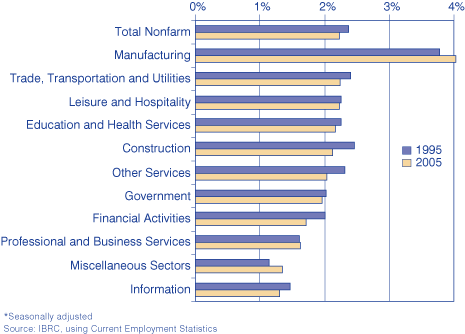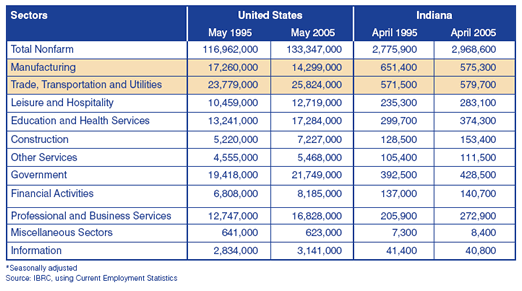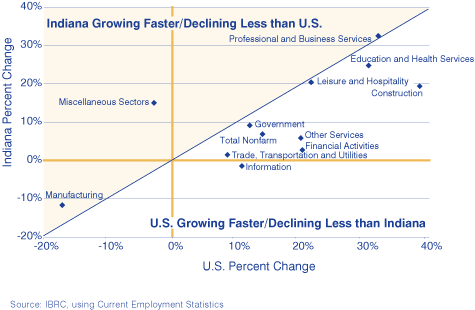Indiana's Manufacturing Advantage
With General Motors Corp. announcing that it will cut 25,000 jobs, many Hoosiers are concerned about the impact on our state. Local leaders tend to be optimistic about the prospects for their individual communities because GM has made significant investments in local plants in recent years. At this point, however, for anyone outside GM, the information the company will use to make its final determination of plant reductions or closings is not available.
We may gain a better understanding from what has been happening to employment in Indiana and the United States over the past 10 years. With data for May 1995 and 2005, we can see how Indiana has tracked with, or differed from, the nation.
In 1995, Indiana had 2.4 percent of the nation’s nonfarm employment; by 2005, this figure had fallen to 2.2 percent (see Figure 1). Manufacturing was, and still is, where Indiana is most differentiated from the nation. In 1995, the Hoosier state had 3.8 percent of U.S. manufacturing jobs, compared to just over 4 percent in 2005. Only Indiana’s manufacturing and miscellaneous sectors saw an increase in Indiana’s share of U.S. employment.
Figure 1: Indiana's Share of U.S. Employment,* 1995 and 2005

Ten years ago, the largest sector in Indiana was manufacturing with 651,400 jobs—79,900 above trade, transportation and utilities. Today the positions are reversed. Trade, transportation and utilities are on top with 579,700 jobs—4,400 above manufacturing (see Table 1).
Table 1: U.S. and Indiana Employment,* 1995 and 2005

During the decade, from 1995 to 2005, manufacturing declined from 23.5 percent of all nonfarm jobs in Indiana to 19.4 percent. Figure 2 shows how several sectors of the state’s economy increased their shares. For example, professional and business services (accountants, attorneys, architects, etc.) increased from 7.4 percent to 9.2 percent of the state’s nonfarm jobs. Nationally, manufacturing’s share of nonfarm employment went from 14.8 percent to 10.7 percent.
Figure 2: Indiana's Job Distribution

Another way to look at these changes is to ask, “What portion of jobs would have to be shifted to other sectors to obtain identical distributions?” For example, in 1995, 9.1 percent of Indiana jobs would have to have been shifted to other sectors to obtain the same percentage distribution as the United States in that year. In 2005, 8.8 percent of the state’s jobs would have to have been changed among the various sectors. This tells us that Indiana’s employment structure is moving toward the national pattern.
Between 1995 and 2005, most Indiana sectors did not grow as rapidly as their U.S. counterparts (see Figure 3). The differences in growth rates can be converted into jobs. This is the traditional “shift-share analysis,” where a state or community is compared with a larger unit (the nation or a state).
Figure 3: Percent Change in Employment, 1995 to 2005

First, we calculate the number of jobs Indiana would have gained if it had grown at the national rate (see Column A in Table 2). This would be Indiana’s share of national growth. The actual change in employment is shown in Column B. Subtracting the hypothetical change from the actual change gives us the shift in employment that took place, as shown in Column C.
Table 2: Shift-Share Analysis, 1995 to 2005

Thus, Indiana may be said to have had a competitive advantage in professional and business services. Had the state experienced the same growth rate as the nation’s 32 percent, it would have added about 65,900 jobs in this sector. However, the state’s growth rate was 32.5 percent, and it actually gained 67,000 jobs in professional and business services. Thus, we say that the state had a differential advantage of nearly 1,100 jobs in this sector.
Manufacturing was our best performing sector over the past 10 years in these terms. If the Hoosier state had lost manufacturing jobs at the national rate, it would have seen a decline of over 111,700 jobs. But the state lost 76,100 which left a differential advantage of 35,649 jobs.
If these data are indicative of future changes, we may expect that the GM job cuts will not be as much to the state’s disadvantage as might be expected. There seems to be something about Indiana that says this state remains a good place for manufacturing activity.
By Morton Marcus, Director Emeritus
Indiana Business Research Center, Kelley School of Business, Indiana University
